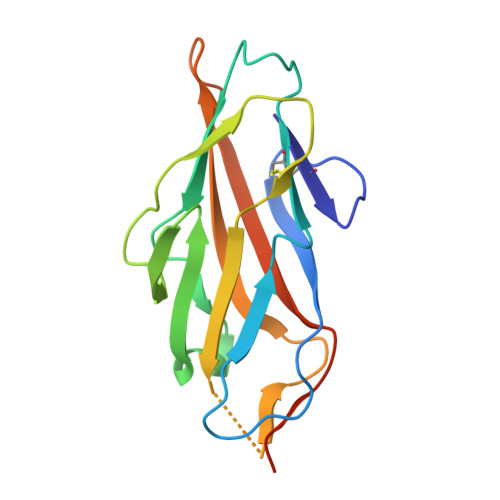Structure-based discovery of glycomimetic FmlH ligands as inhibitors of bacterial adhesion during urinary tract infection.
Kalas, V., Hibbing, M.E., Maddirala, A.R., Chugani, R., Pinkner, J.S., Mydock-McGrane, L.K., Conover, M.S., Janetka, J.W., Hultgren, S.J.(2018) Proc Natl Acad Sci U S A 115: E2819-E2828
- PubMed: 29507247
- DOI: https://doi.org/10.1073/pnas.1720140115
- Primary Citation of Related Structures:
6AOW, 6AOX, 6AOY, 6ARM, 6ARN, 6ARO, 6AS8 - PubMed Abstract:
Treatment of bacterial infections is becoming a serious clinical challenge due to the global dissemination of multidrug antibiotic resistance, necessitating the search for alternative treatments to disarm the virulence mechanisms underlying these infections. Uropathogenic Escherichia coli (UPEC) employs multiple chaperone-usher pathway pili tipped with adhesins with diverse receptor specificities to colonize various host tissues and habitats. For example, UPEC F9 pili specifically bind galactose or N -acetylgalactosamine epitopes on the kidney and inflamed bladder. Using X-ray structure-guided methods, virtual screening, and multiplex ELISA arrays, we rationally designed aryl galactosides and N -acetylgalactosaminosides that inhibit the F9 pilus adhesin FmlH. The lead compound, 29β-NAc, is a biphenyl N -acetyl-β-galactosaminoside with a K i of ∼90 nM, representing a major advancement in potency relative to the characteristically weak nature of most carbohydrate-lectin interactions. 29β-NAc binds tightly to FmlH by engaging the residues Y46 through edge-to-face π-stacking with its A-phenyl ring, R142 in a salt-bridge interaction with its carboxylate group, and K132 through water-mediated hydrogen bonding with its N-acetyl group. Administration of 29β-NAc in a mouse urinary tract infection (UTI) model significantly reduced bladder and kidney bacterial burdens, and coadministration of 29β-NAc and mannoside 4Z269, which targets the type 1 pilus adhesin FimH, resulted in greater elimination of bacteria from the urinary tract than either compound alone. Moreover, FmlH specifically binds healthy human kidney tissue in a 29β-NAc-inhibitable manner, suggesting a key role for F9 pili in human kidney colonization. Thus, these glycoside antagonists of FmlH represent a rational antivirulence strategy for UPEC-mediated UTI treatment.
- Center for Women's Infectious Disease Research, Washington University School of Medicine, St. Louis, MO 63110.
Organizational Affiliation:

















